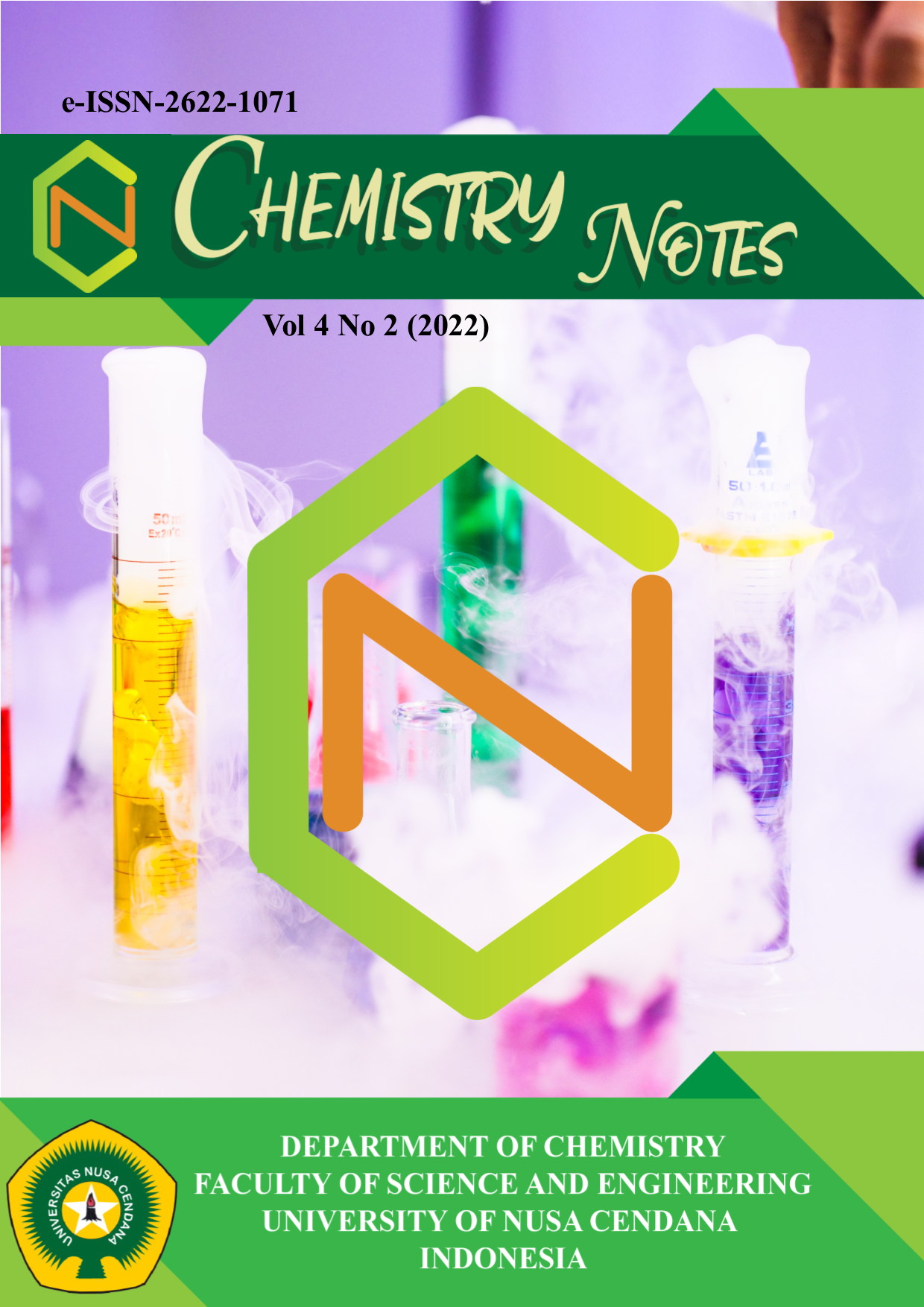Ekstraksi Gliserin Dari Biodiesel Menggunakan Deep Eutectic Solvent Berbasis Asam Tanat-Cholin Chloride Sebagai Ekstraktan
Abstract
Biodiesel is a concern for many parties because it is environmentally friendly, non-toxic, and renewable. One of the problems faced in the use of biodiesel as an alternative energy is the process of purification from impurities and by-products such as glycerin which is complicated and expensive. Glycerin can cause saponification, increase ignition delay, incomplete combustion, blockage and increase engine maintenance costs. In this study, deep eutectic solvents (DES) synthesized from choline chloride (ChCl) salts and tannic acid were used as extractants for the extraction of glycerin from biodiesel synthesized through palm oil transesterification with methanol as a trans substituent and KOH as a catalyst. The effect of the composition of the constituent moles of DES and the ratio of biodiesel-DES mass to glycerin content of biodiesel has been studied. The results showed that the higher the content of ChCl salt in DES and the greater the ratio of biodiesel-DES, the lower the glycerin content in biodiesel, with the highest decrease of 65.7693% (glycerin content after extraction of 2.0193%) obtained from the composition of the mole DES 1:47 (Tannic acid:ChCl) and the mass ratio of biodiesel-DES 1:3. The biodiesel produced has not met SNI 1782, which is 0.02%.
Downloads
References
2. Verma, P., Sharma, M. P., & Dwivedi, G. (2016). Impact of alkohol on biodiesel production and properties. renewable and Sustainable Energy Reviews, 56, 319–333. https://doi.org/10.1016/j.rser.2015.11.048
3. Lin, C.-Y. (2013).Strategies for promoting biodiesel use in marine vessels. Marine Policy, 40,84-90.doi:10.1016/j.marpol.2013.01.003. https://doi.org/10.1016/j.marpol.2013.01.003
4. Dwivedi, G., Jain, S., & Sharma, M. P. (2011). Impact analysis of biodiesel on engine performance - A review. In Renewable and Sustainable Energy Reviews (Vol. 15, Issue 9, pp. 4633–4641). https://doi.org/10.1016/j.rser.2011.07.089
5. Banga, S and Varshney, K.P. (2010). Effect of impurities on performance of biodiesel: A review. Journal of Scientific & Industrial Research, 69.575-579. (PDF) Effect of impurities on performance of biodiesel: A review (researchgate.net)
6. Shahbaz, K. A.; Mjalli, F. S.; Hashim, M. A.; AlNashef, I. M. (2010) Using deep eutectic solvents for removal glycerol from palm oil-based biodiesel. J. Appl. Sci., 10 (24), 3349–3354
7. Gomes, M. C. S., Pereira, N. C., & Barros, S. T. D. de. (2010). Separation of biodiesel and glycerol using ceramic membranes. Journal of Membrane Science, 352(1-2), 271–276. doi:10.1016/j.memsci.2010.02.030
8. Faccini, C. S., da Cunha, M. E., Moraes, M. S. A., Krause, L. C., Manique, M. C., Rodrigues, M. R. A., Benvenutti, E. v., & Caramão, E. B. (2011). Dry washing in biodiesel purification: A comparative study of adsorbents. Journal of the Brazilian Chemical Society, 22(3), 558–563. https://doi.org/10.1590/S0103-50532011000300021
9. Berrios, M., & Skelton, R. L. (2008). Comparison of purification methods for biodiesel. Chemical Engineering Journal, 144(3), 459–465. https://doi.org/10.1016/j.cej.2008.07.019
10. Wang, G. N., Dai, Y., Hu, X. B., Xiao, F., Wu, Y. T., Zhang, Z. B., & Zhou, Z. (2012). Novel ionic liquid analogs formed by triethylbutylammonium carboxylate-water mixtures for CO2 absorption. Journal of Molecular Liquids, 168, 17–20. doi:10.1016/j.molliq.2011.12.006
11. Gu, L., Huang, W., Tang, S., Tian, S., & Zhang, X. (2015). A novel deep eutectic solvent for biodiesel preparation using a homogeneous base catalyst. Chemical Engineering Journal, 259, 647–652. https://doi.org/10.1016/j.cej.2014.08.026
12. Shahbaz, K., Mjalli, F. S., Hashim, M. A., & AlNashef, I. M. (2011). Using Deep Eutectic Solvents Based on Methyl Triphenyl Phosphunium Bromide for the Removal of Glycerol from Palm-Oil-Based Biodiesel. Energy & Fuels, 25(6), 2671–2678. doi:10.1021/ef2004943
13. Ola, P. D., & Matsumoto, M. (2018).Use of deep eutectic solvent as extractant for separation of Fe (III) and Mn (II) from aqueous solution. Separation Science and Technology, 1–7. https://doi.org/10.1080/01496395.2018.1517796
14. Hayyan, M., Mjalli, F. S., Hashim, M. A., & AlNashef, I. M. (2010). A novel technique for separating glycerine from palm oil-based biodiesel using ionic liquids. Fuel Processing Technology, 91(1), 116–120. https://doi.org/10.1016/j.fuproc.2009.09.002
15. Abbott, A. P., Cullis, P. M., Gibson, M. J., Harris, R. C., & Raven, E. (2007). Extraction of glycerol from biodiesel into a eutectic based ionic liquid. Green Chemistry, 9(8), 868. doi:10.1039/b702833d
16. Date, K.Y. (2021). Sintesis dan Karakterisasi Deep Eutectic Solvent(DES) Berbasis Kolin Klorida(ChCl) dengan Hydrogen Bond Donor(HBD) Asam Tanat.(Skripsi, Universitas Nusa Cendana)
17. Yusuf, N. N. A. N., Kamarudin, S. K., & Yaakub, Z. (2011). Overview on the current trends in biodiesel production. Energy Conversion and Management, 52 (7),2741–2751. https://doi.org/10.1016/j.enconman.2010.12.004
18. Chozhavendhan, S., Vijay Pradhap Singh, M., Fransila, B., Praveen Kumar, R., & Karthiga Devi, G. (2020). A review on influencing parameters of biodiesel production and purification processes. Current Research in Green and Sustainable Chemistry, 1-2, 1–6. doi:10.1016/j.crgsc.2020.04.002
19. Smith, E. L., Abbott, A. P., & Ryder, K. S. (2014). Deep Eutectic Solvents (DESs) and Their Applications. Chemical Reviews, 114(21), 11060–11082. doi: 10.1021/cr300162p
20. Hansen, B. B., Spittle, S., Chen, B., Poe, D., Zhang, Y., Klein, J. M., Horton, A., Adhikari, L., Zelovich, T., Doherty, B. W., Gurkan, B., Maginn, E. J., Ragauskas, A., Dadmun, M., Zawodzinski, T. A., Baker, G. A., Tuckerman, M. E., Savinell, R. F., & Sangoro, J. R. (2021). Deep Eutectic Solvents: A Review of Fundamentals and Applications. In Chemical Reviews (Vol. 121, Issue 3, pp. 1232–1285). American Chemical Society. https://doi.org/10.1021/acs.chemrev.0c00385
21. Abbott, A. P., Capper, G., & Gray, S. (2006). Design of Improved Deep Eutectic Solvents Using Hole Theory. ChemPhysChem, 7(4), 803–806. doi:10.1002/cphc.200500489
In order to publish in Chemistry Notes, authors are required to agree to the copyright permission stating that the authors give the publisher the right to reproduce, display or distribute the accepted manuscript. In this agreement the authors also automatically declare that the submitted manuscript is exempted from plagiarism issue and conflict of interest among the authors.

 Pius D. Ola(1*)
Pius D. Ola(1*)





